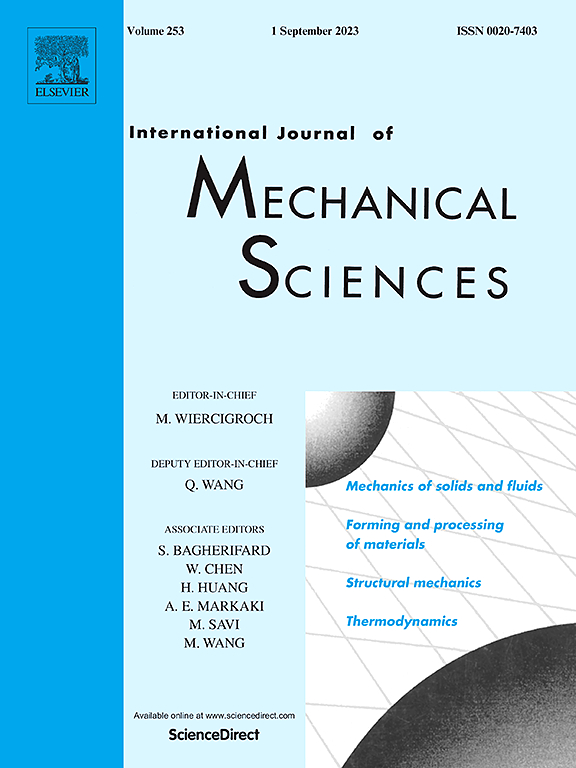Dual-sensor blade tip timing with multi-source information and adaptive dictionary update
IF 7.1
1区 工程技术
Q1 ENGINEERING, MECHANICAL
International Journal of Mechanical Sciences
Pub Date : 2025-03-22
DOI:10.1016/j.ijmecsci.2025.110178
引用次数: 0
Abstract
Blade tip timing (BTT) has emerged as a critical non-contact vibration measurement technique, increasingly supplanting traditional strain gauge methods for monitoring the operational safety of high-speed rotating machinery, such as aircraft engines and gas turbines. Despite its advantages, conventional BTT approaches face several limitations: undersampling often leads to the loss of high-frequency signals; the requirement for multiple sensors and stringent layout specifications escalates system complexity and cost; and dependence on a single displacement data source restricts the extraction of comprehensive vibration features. Furthermore, traditional BTT methods lack adaptability to varying operating conditions, impeding accurate signal reconstruction. To overcome these challenges, this study proposes a novel dual-sensor BTT sparse reconstruction method. This approach leverages multi-source information, including both displacement and velocity data, to adapt to diverse operating conditions. It employs a dynamic dictionary update process based on the primary frequency range during sparse reconstruction, eliminating the need for at least four sensors to reconstruct synchronous vibration signals under constant speed conditions. This innovation reduces sensor layout constraints and enhances the robustness and accuracy of signal reconstruction. The proposed method is experimentally validated using dual capacitive and dual eddy current sensors for vibration signal identification. The results indicate that integrating multi-source information significantly improves the accuracy and reliability of vibration signal reconstruction, rendering the method highly effective for health monitoring and fault diagnosis in high-speed rotating machinery.

双传感器叶尖定时与多源信息和自适应字典更新
叶尖定时(BTT)已成为一种重要的非接触式振动测量技术,越来越多地取代传统的应变测量方法,用于监测高速旋转机械(如飞机发动机和燃气轮机)的运行安全性。尽管传统的BTT方法有很多优点,但仍面临一些限制:欠采样经常导致高频信号的丢失;对多个传感器和严格的布局规范的要求增加了系统的复杂性和成本;对单一位移数据源的依赖限制了综合振动特征的提取。此外,传统的BTT方法缺乏对不同操作条件的适应性,影响了信号的准确重构。为了克服这些挑战,本研究提出了一种新的双传感器BTT稀疏重建方法。这种方法利用多源信息,包括位移和速度数据,以适应不同的操作条件。在稀疏重建过程中,采用基于主频率范围的动态字典更新过程,消除了在等速条件下重构同步振动信号至少需要4个传感器的问题。这一创新减少了传感器布局的限制,提高了信号重构的鲁棒性和准确性。采用双电容式和双涡流传感器对振动信号进行了识别,验证了该方法的有效性。结果表明,多源信息的融合显著提高了振动信号重构的准确性和可靠性,使该方法在高速旋转机械的健康监测和故障诊断中具有较高的有效性。
本文章由计算机程序翻译,如有差异,请以英文原文为准。
求助全文
约1分钟内获得全文
求助全文
来源期刊

International Journal of Mechanical Sciences
工程技术-工程:机械
CiteScore
12.80
自引率
17.80%
发文量
769
审稿时长
19 days
期刊介绍:
The International Journal of Mechanical Sciences (IJMS) serves as a global platform for the publication and dissemination of original research that contributes to a deeper scientific understanding of the fundamental disciplines within mechanical, civil, and material engineering.
The primary focus of IJMS is to showcase innovative and ground-breaking work that utilizes analytical and computational modeling techniques, such as Finite Element Method (FEM), Boundary Element Method (BEM), and mesh-free methods, among others. These modeling methods are applied to diverse fields including rigid-body mechanics (e.g., dynamics, vibration, stability), structural mechanics, metal forming, advanced materials (e.g., metals, composites, cellular, smart) behavior and applications, impact mechanics, strain localization, and other nonlinear effects (e.g., large deflections, plasticity, fracture).
Additionally, IJMS covers the realms of fluid mechanics (both external and internal flows), tribology, thermodynamics, and materials processing. These subjects collectively form the core of the journal's content.
In summary, IJMS provides a prestigious platform for researchers to present their original contributions, shedding light on analytical and computational modeling methods in various areas of mechanical engineering, as well as exploring the behavior and application of advanced materials, fluid mechanics, thermodynamics, and materials processing.
 求助内容:
求助内容: 应助结果提醒方式:
应助结果提醒方式:


